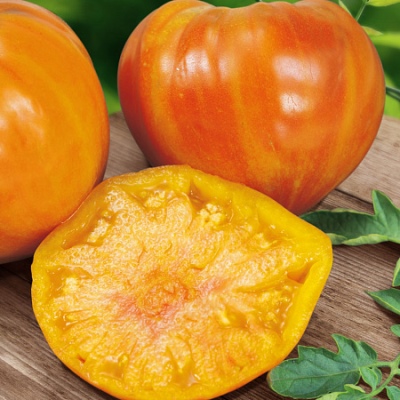
- Category: grade
- Growth type: indeterminate
- Appointment: fresh consumption, for whole-fruit preservation, for juice
- Ripening period: early
- Ripening time, days: 95-98
- Growing conditions: for open ground, for greenhouses
- Bush size: tall
- Bush height, cm: 180-200
- Ripe fruit color: two-tone orange-crimson
- Fruit shape: heart-shaped
Tomato Sweet Amber is unique in many respects - it is a bicolor color, a special melon taste, and an incredibly high yield (up to 20 kg per m2). It is interesting that the culture differs in good fruiting, regardless of where it grows, in closed or open ground.
Description of the variety
Sweet amber is a variety of an indeterminate type of development. A tall bush stretches up to 180 cm, there are also two-meter specimens.
The main qualities of the fruit
The fruits of varietal tomato have a characteristic heart-shaped shape. As for the color of the skin, which is very thin in this variety, when ripe it becomes two-colored, almost exotic: the main field is orange, and along it there are raspberry veins.
Tomatoes are large in weight - from 350 grams to half a kilogram. The fruits set perfectly in a variety of, even unfavorable climatic conditions. An interesting feature: the color of the pulp can be different depending on the season - in the summer it is mostly pink, and in the fall it turns orange.
Taste characteristics
Special attention should be paid to the amazing taste of Sweet Amber. The pulp of the fruit of this variety is fleshy, seedless, fibrous cells are also absent. But there is a pronounced tomato flavor and a fruity aftertaste. Moreover, just like the color of the pulp, the taste of these tomatoes is always different: in hot weather, notes of melon will prevail, and closer to autumn, with the onset of cooler weather, you can even feel the taste of peaches or apricots.
The fruits are often consumed fresh, and also used for whole-fruit canning, juice preparation.
Ripening and fruiting
Sweet amber is an early ripe tomato variety. As for the timing of full maturation, it will take 95-98 days. Differs in a rather long fruiting period. Harvesting can be scheduled from July to September. In some situations, it can bear fruit even until the very frost. If you remove green tomatoes in autumn, they will ripen perfectly on the windowsill.
Yield
Tomatoes Sweet amber impress with their rather high yield. Up to 7 kg are harvested from one bush. And from 1 square meter - up to 20 kg.
The timing of planting seedlings and planting in the ground
The timing of planting seedlings and their subsequent transfer to the ground is detailed: sowing of seed material in a container is carried out in March-April, and grown bushes are planted in the ground in May, in some cases in June. But it depends on the region and weather conditions.

Growing tomato seedlings is an extremely important process, because it largely depends on whether the gardener can harvest at all. All aspects must be taken into account, from seedbed preparation to planting in the ground.
Landing scheme
The optimal scheme for planting tomatoes in a permanent place is 40 x 50 centimeters. This is necessary so that each bush gets a sufficient amount of nutrients, light and moisture.

Growing and care
Given the high yield of the Sweet Amber culture, the bushes are always literally bursting with large fruits. Therefore, plants simply need a good tie to a strong support.
The rest of the care does not differ from the cultivation of any other varieties of tomatoes. It should include mandatory irrigation of the crop, and loosening, and mulching, as well as feeding and prevention.




A plant needs different micronutrients at each stage of growth. All fertilizers can be divided into two groups: mineral and organic. Folk remedies are often used: iodine, yeast, bird droppings, eggshells.
It is important to observe the rate and period of feeding. This also applies to folk remedies and organic fertilizers.
Disease and pest resistance
Tomatoes of the described variety are quite resistant to various diseases. The exception is late blight, which can infect a culture. Therefore, it is required to carry out preventive spraying with appropriate preparations.


Resistant to adverse weather conditions
The variety has good stress resistance, therefore it ripens in almost any conditions.
Growing regions
The culture is recommended for cultivation in all regions of the Russian Federation.

























































































